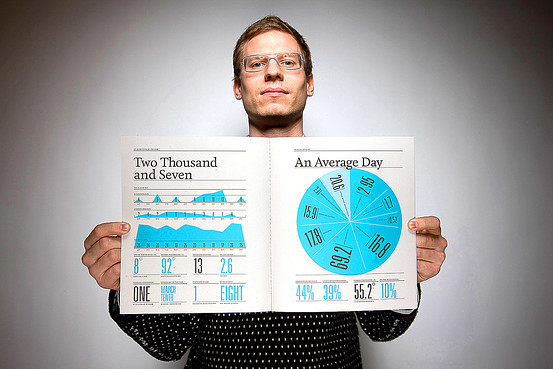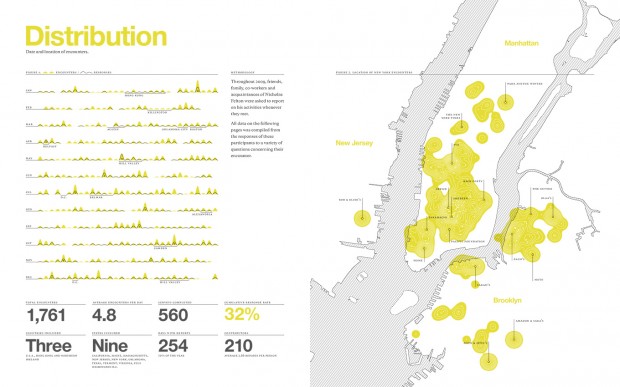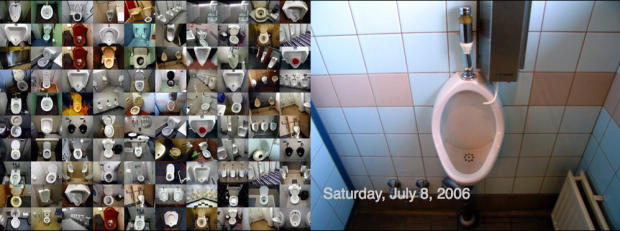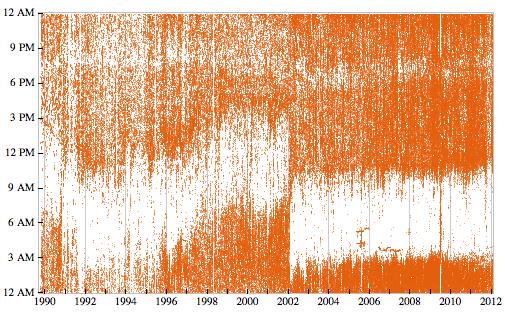Here are background materials for the Quantified Selfie project.
Things to Read:
- Maureen O’Connor. “Heartbreak and the Quantified Selfie“. NY Magazine, 12/2/13.
Abstract: Quantified Selfies offer the chance for self-discovery. Because digital data is vast and immaterial, viewing the aggregate can be difficult, and the process of organizing information can reveal unexpected truths. - Robert Crease, “Measurement and Its Discontents“. New York Times, October 22, 2011.
Abstract: Why are we still stymied when trying to measure intelligence, schools, welfare and happiness? The problem is not that we don’t yet have precise enough tools for measuring such things; it’s that there are two wholly different ways of measuring. - Judith Donath et al. “Data portraits“. Proceedings of SIGGRAPH 2010, Pages 375-383.
Abstract: Data portraits depict their subjects’ accumulated data rather than their faces. They can be visualizations of discussion contributions, browsing histories, social networks, travel patterns, etc. They are subjective renderings that mediate between the artist’s vision, the subject’s self-presentation, and the audience’s interest. Designed to evocatively depict an individual, a data portrait can be a decorative object or be used as an avatar, one’s information body for an online space. Data portraits raise questions about privacy, control, aesthetics, and social cognition. These questions become increasingly important as more of our interactions occur online, where we exist as data, not bodies.
Some artists have made self-tracking a core part of their artistic practice.
Nick Felton (http://feltron.com) has produced “Annual Reports” about his activities since 2005. He compiles odd minutia and data about the mundane moments of his life, tracking restaurants, beverages, types of meat eaten and a long list of other esoteric data points. Felton is also the co-founder of Daytum.com, and is a former member of the product design team at Facebook.


American artist Hasan Elahi has been pre-emptively surveilling himself for the FBI and the Department of Homeland Security, after enduring scrutinous but unwarranted interrogations shortly after 9/11/2001. Elahi explains that he “doesn’t look good in orange.” (Elahi also has a TED talk.)

Other Approaches
Some people have tracked and visualized their physical and mental health.
Doug Kanter , an NYU ITP graduate student, is a Type-1 diabetic who has used visualizations to study how self-tracking influences his diabetes control.
- Katie McCurdy produced a timeline visualization of her health issue.
- After her marriage ended, one woman visualized her heartbreak in a series of information visualizations: http://quantifiedbreakup.tumblr.com/. This is discussed in one of the articles linked above.
Others have tracked and visualized their activities and productivity.
Mathematician/entrepreneur Stephen Wolfram investigated “The Personal Analytics of My Life“. Here, for example, he studied the send-times of a quarter-million of his own outgoing emails:
David El Achkar, a consultant, created tools to capture his work habits and discussed “How Six Months of Tracking Everything Increased my Awareness”:
